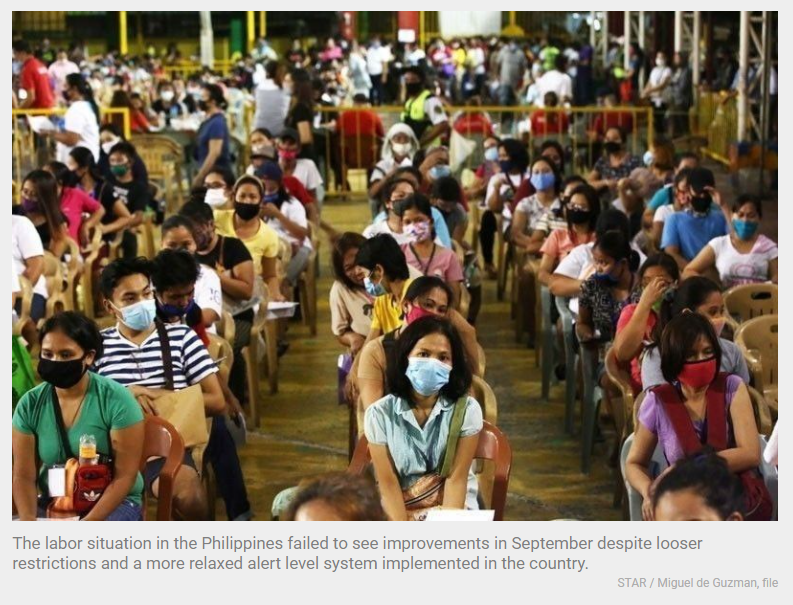Philippines: Jobless rate jumps to year-high 8.9%
MANILA, Philippines — Unemployment further worsened in September despite the easing of mobility curbs, indicating the long-term scarring impact of repeated lockdowns on the labor market.
The labor situation in the Philippines failed to see improvements in September despite looser restrictions and a more relaxed alert level system implemented in the country.
The latest report of the Philippine Statistics Authority (PSA) showed that the unemployment rate jumped to 8.9 percent from 8.1 percent in August, translating to 4.25 million unemployed Filipinos in the labor force.
Mobility during the month was significantly looser than in August, especially as Metro Manila was downgraded to modified enhanced community quarantine for the first two weeks and was later transferred to Alert Level 4 in the remaining weeks of September.
However, this failed to make a dent on employment as joblessness worsened to the highest rate since January or when the government started the monthly labor force survey.
Leonardo Lanzona, labor economist and professor at Ateneo De Manila University, said the impact of the previous lockdowns and the insufficient government programs are taking their toll.
“The problem is not just the lockdown per se but the scarring effects brought by all the continuous rounds of lockdowns. It is not a matter of switching the light on and off and expecting the workers will still be there,” Lanzona told The STAR.
The National Economic and Development Authority, on the other hand, said employment prospects remain promising as the country shifts to granular lockdowns.
Socioeconomic Planning Secretary Karl Chua said better labor outcomes in October may occur when the country sees the full impact of the implementation of granular lockdowns in Metro Manila.
But Lanzona said that a proactive job creation program with decent work conditions is needed.
“Nothing short of comprehensive job creation with adequate work standards will revive the economy. Work today involves certain health risks, and health insurance programs should also be strengthened to raise labor participation rates,” he said.
In fact, the country’s labor force participation rate, or those Filipinos aged 15 years and above, slightly declined to 63.3 percent of the total working age population from 63.6 percent.
This is equivalent to around 47.85 million economically active Filipinos whether employed or looking for work – a decrease from the 48.12 million in August.
PSA head Dennis Mapa said some factors that contributed to the decline in labor participation include the start of the school year while others are still waiting for progress in their applications.
Lanzona, for his part, said the easing of travel restrictions globally is prompting more Filipinos to decide to work outside the country, thus the low labor market participation rate.
The higher unemployment rate combined with the lower labor force participation rate led to a net employment loss of 642,000.
The biggest driver of the net employment loss was agriculture, as Typhoon Jolina affected some 30,000 hectares of agricultural lands and contributed to around 900,000 employment loss in the sector.
The decline came after the sector regained 1.9 million employment in August.
Apart from agriculture, the industries that showed the largest decrease in job creation include manufacturing at 343,000, information and communication at 126,000, and mining and quarrying at 75,000.
Increases, on the other hand, were recorded in wholesale and retail trade, public administration and defense, and education.
Meanwhile, the underemployment rate, pertaining to the proportion of workers who were looking for more hours of work, marginally eased to 14.2 percent or 6.18 million Filipinos from 14.7 percent or 6.48 million the previous month.
As restrictions are relaxed, the average weekly hours of work of an employed person increased to 40.2 hours from 39.6 hours in August.
Workers are grouped into the three sectors, namely, agriculture, industry, and the services sector. Those in the services sector comprised most of the employed persons, accounting for 57.8 percent share during the month.
Services sector was followed by agriculture with 23.5 percent share while the industry sector accounted for the smallest share of 18.7 percent.
Source: https://www.philstar.com/business/2021/11/05/2138997/jobless-rate-jumps-year-high-89


 Thailand
Thailand




